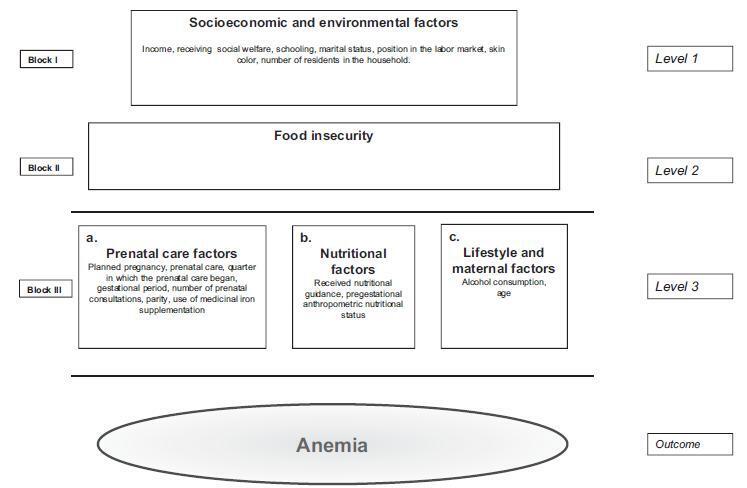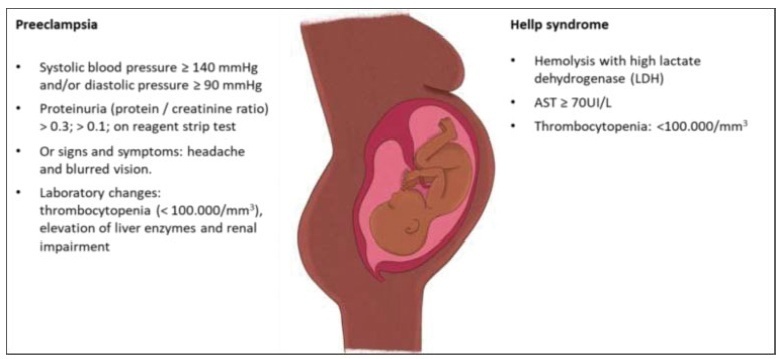Summary
Revista Brasileira de Ginecologia e Obstetrícia. 2007;29(8):383-386
Summary
Revista Brasileira de Ginecologia e Obstetrícia. 2014;36(9):383-386
DOI 10.1590/SO100-720320140005099
Summary
Revista Brasileira de Ginecologia e Obstetrícia. 2002;24(6):383-387
DOI 10.1590/S0100-72032002000600005
Purpose: to evaluate the effectiveness of diagnostic amnioinfusion in severe oligohydramnios. Methods: twelve patients with severe oligohydramnios in the second and third trimester of pregnancy were submitted to amnioinfusion. The procedure was done using a warm physiological saline at a rate of 20 mL/min followed by the instillation of 5 mL of dye. The amniotic fluid index (AFI) was measured before the procedure and 30 min afterwards and in case of fetal anomalies, it was documented. The gestational age ranged from 18 to 34 weeks (average 25 ± 4 weeks). The average of the initial ILA was 10.3cm and after the procedure was 16.4 cm. The volume of saline solution infused ranged from 300 to 1000 mL (605.4 ± 224.1 mL). Results: in nine patients (75%) the procedure led to an etiologic diagnosis: four cases of premature rupture of membranes and major malformations in five fetuses. In two patients the oligohydramnios was considered idiopathic and in one patient the pathological examination revealed a placental infarct. Nine pregnancies (75%) were interrupted after the diagnosis and in three cases it was maintained for 8.8 weeks after the amnioinfusion. All fetuses died, seven of them had neonatal death and the remaining had intrauterine death. Conclusion: amnioinfusion is an effective method with high precision, enabling the etiologic diagnosis of severe oligohydramnios in 75% of the cases.
Summary
Revista Brasileira de Ginecologia e Obstetrícia. 2023;45(7):384-392
To assess the potential relationship of clinical status upon admission and distance traveled from geographical health district in women with gestational trophoblastic disease (GTD).
This is a cross-sectional study including women with GTD from the 17 health districts from the São Paulo state (I–XVII), Brazil, referred to the Botucatu Trophoblastic Disease Center (specialized center, district VI), between 1990 and 2018. At admission, hydatidiform mole was assessed according to the risk score system of Berkowitz et al. Gestational trophoblastic neoplasia was evaluated using the International Federation of Gynecology and Obstetrics / World Health Organization (FIGO/WHO) staging/risk score. Data on demographics, clinical status and distance traveled were collected. Multiple regression analyses were performed.
This study included 366 women (335 hydatidiform mole, 31 gestational trophoblastic neoplasia). The clinical status at admission and distance traveled significantly differed between the specialized center district and other districts. Patients referred from health districts IX (β = 2.38 [0.87–3.88], p = 0.002) and XVI (β = 0.78 [0.02–1.55], p = 0.045) had higher hydatidiform mole scores than those from the specialized center district. Gestational trophoblastic neoplasia patients from district XVI showed a 3.32 increase in FIGO risk scores compared with those from the specialized center area (β = 3.32, 95% CI = 0.78–5.87, p = 0.010). Distance traveled by patients from districts IX (200km) and XVI (203.5km) was significantly longer than that traveled by patients from the specialized center district (76km).
Patients from health districts outside the specialized center area had higher risk scores for both hydatidiform mole and gestational trophoblastic neoplasia at admission. Long distances (>80 km) seemed to adversely influence gestational trophoblastic disease clinical status at admission, indicating barriers to accessing specialized centers.
Summary
Revista Brasileira de Ginecologia e Obstetrícia. 2018;40(7):384-389
The main objective of this study was to examine the diagnostic performance of the first-trimester combined test for aneuploidies in unselected pregnancies from Rio de Janeiro and compare it with the examples available in the literature.
We investigated 3,639 patients submitted to aneuploidy screening from February 2009 to September 2015. The examination is composed of the Fetal Medicine Foundation risk evaluation based on nuchal translucency evaluation, mother’s age, presence of risk factors, presence of the nasal bone and Doppler of the ductus venous in addition to biochemical analysis of pregnancy-associated plasma protein A (PAPP-A) and beta-human chorionic gonadotropin (β-hCG) markers. The cut-off point for high risk for aneuploidies was defined as greater than 1:100, with intermediate risk defined between 1:100 and 1:1,000, and low risk defined as less than 1:1,000. The variable aneuploidy was considered as a result not only of trisomy of chromosome 21 but also trisomy of chromosomes 13 and 18.
Excluding the losses, the results of 2,748 patients were analyzed. The firsttrimester combined test achieved 71.4% sensitivity with a 7.4% false-positive (FP) rate, specificity of 92.6%, positive predictive value (PPV) of 6.91% and negative predictive value (NPV) of 99.76%, when the cut-off point considered was greater than 1:1,000. Through a receiving operating characteristics (ROC) curve, the cut-off point that maximized the sensitivity and specificity for the diagnosis of aneuploidies was defined as 1:1,860. When we adjusted the false-positive (FP) rate to 5%, the detection rate for this analysis is 72.7%, with a cut-off point of 1:610.
The combined test of aneuploidy screening showed a detection rate inferior to those described in the literature for a higher FP rate.
Summary
Revista Brasileira de Ginecologia e Obstetrícia. 2017;39(8):384-396
To identify the prevalence of anemia and its relation to food insecurity (FI) and other determinants in pregnant women.
A cross-sectional, cohort-nested study, with the participation of 245 pregnant women who were cared for at Family Health Units in the municipality of Santo Antônio de Jesus, Bahia, Brazil. The participants underwent blood tests for hemoglobin levels, anthropometric examinations, and answered a structured questionnaire. The hemoglobin (Hb) parameter (Hb < 11 g/dL) was used for the classification of the diagnosis of anemia. Food insecurity was evaluated using the North American short-scale food insecurity assessment. Logistic regression was adopted for the statistical analyses, based on a hierarchical conceptual model that enabled the measurement of the decomposition of the total effect of its non-mediated and mediated components using the proposed hierarchical levels.
The prevalence of anemia in the studied population was of 21.8%, and the average hemoglobin was 12.06 g/dL (standard deviation [SD]: 1.27). Food insecurity was identified in 28.16% of the pregnant women. The average maternal age was 25.82 years (SD: 5.94). After ranking, the variables positively associated with anemia remained significant: FI (odds ratio [OR] =3.63; 95% confidence interval [95%CI]: 1.77-7.45); not undergoing prenatal care (OR = 5.15;95%CI: 1.43-18.50); multiparity (OR = 2.27;95%CI: 1.02-5.05); and non-supplementation of iron medication (OR = 2.45; 95%CI: 1.04-5.76). The results also indicated that the socioeconomic and environmental factors were largely mediated by food insecurity and factors regarding prenatal care.
In the present study, the chance of occurrence of anemia in pregnant women was significantly higher,mainly among women: in situations of food insecurity, not undergoing prenatal care, not having received iron supplements, and who are multiparous.

Summary
Revista Brasileira de Ginecologia e Obstetrícia. 2021;43(5):384-394
Coronavirus disease 2019 (COVID-19) is a disease caused by a newly discovered coronavirus, severe acute respiratory syndrome coronavirus 2 (SARSCoV-2), which usually leads to non-specific respiratory symptoms. Although pregnant women are considered at risk for respiratory infections by other viruses, such as SARS and Middle East respiratory syndrome (MERS), little is known about their vulnerability to SARS-CoV-2. Therefore, this study aims to identify and present the main studies on the topic, including the postpartum period.
In this narrative review, articles were searched in various databases, organizations, and health entities using keywords compatible with medical subject headings (MeSH), such as: COVID-19, pregnancy, vertical transmission, coronavirus 2019, and SARS-CoV-2.
The review of the scientific literature on the subject revealed that pregnant women with COVID-19 did not present clinical manifestations significantly different from those of non-pregnant women; however, there are contraindicated therapies. Regarding fetuses, studies were identified that reported that infection by SARS-CoV-2 in pregnant women can cause fetal distress, breathing difficulties and premature birth, but there is no substantial evidence of vertical transmission.
Due to the lack of adequate information and the limitations of the analyzed studies, it is necessary to provide detailed clinical data on pregnant women infected with SARS-CoV-2 and on the maternal-fetal repercussions caused by this infection. Thus, this review may contribute to expand the knowledge of professionals working in the area as well as to guide more advanced studies on the risk related to pregnant women and their newborns. Meanwhile, monitoring of confirmed or suspected pregnant women with COVID-19 is essential, including in the postpartum period.

Summary
Revista Brasileira de Ginecologia e Obstetrícia. 2008;30(8):384-392
DOI 10.1590/S0100-72032008000800003
PURPOSE: the objective of the present study was the development of the Brazilian Portuguese version of Endometriosis Health Profile Questionnaire (EHP-30), the cross-cultural adaptation to Brazil and the evaluation of EHP-30 Portuguese psychometric measures in a Brazilian sample. METHODS: the original instrument in English was translated into Portuguese following international guidelines, going through all stages of translation, back-translation and comparison of the versions for cross-cultural adaptation, face and content validity. A sample of 54 patients with endometriosis was used for internal consistency analyses using the Cronbach alpha. Test-retest reliability was evaluated through the intraclass correlation coefficient (ICC). In order to evaluate the convergent construct validity, the correlation between EHP-30 Portuguese and WHOQOL-Bref and Beck Depression Inventory (BDI) was tested. RESULTS: internal consistency presented alpha values of 0.8 to 0.9 suggesting homogeneity between questions. The test-retest reliability presented ICC of 0.8 to 0.9 showing instrument stability. In the construct validation, strong correlations were demonstrated of the EHP-30 Portuguese self-image scale with physical (-0.6) and psychological domains (-0.6) of WHOQOL-Bref, and EHP-30 Portuguese social support scale with BDI (0.5), confirming good correlation with other quality of life evaluation instruments. CONCLUSIONS: the EHP-30 Portuguese was found to be an easy, quickly applied instrument, and well-accepted by the patients. It presented good psychometric properties with appropriate reliability measures (internal consistency and test-retest reliability) and construct validity. These results show that EHP-30 Portuguese is an adequate instrument for quality of life evaluation in Brazilian women with endometriosis, both in clinical and research setting.
